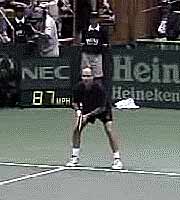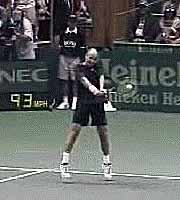|
Commentary
In the old days Connors was known to “see the ball” extremely well, and (not) coincidentally his return of serve was legendary. And now, Andre Agassi has this uncanny vision, and as Connors before, is far and away the preeminent returner in the modern game. There is a story that Agassi was at the baseball
batting cages with friends, he tired of the drill so he charged the
pitching machine and continued to make contact, to the wide-eyed amazement
of his friends.
In the 1970’s William Harrison of La Jolla created a training system called “Vision Dynamics”. Principles included enhancement of depth perception and improved ability to read fast moving balls, so his material was aimed primarily toward baseball batters. Interestingly, George Brett, perennial batting average leader, was one of Harrison’s protégés.
I became aware of this system from the overlap of the material to Tom
Stow’s insistence on posture, balance, and the absolute control of the
head during the stroke. Harrison had many exercises that were meant
to improve the convergence and divergence of the eyes as objects moved
toward and away from the subject, as well as vision exercises performed
simultaneously with various balancing exercises, to reinforce the
relationship between visual acuity and balance (Interestingly Tom Stow
served on Harrison’s advisory board).
Reexamine your own commitment to watching the ball. Certainly, “watch the ball” may be an extremely overused phrase on the teaching court. But in this example, watching the ball is more than paying attention, but rather it is studying the ball and nothing else, it is keen focus; it is impeccable attention while at the same time preparing the racquet. Can you prepare and not lose sight of the ball? Said another way, can you prepare and not move the ball from the center of your vision? Having studied examples of Agassi’s backhand return, my overriding impression is of incredible concentration, and perfect vision. Unit TurnAs Agassi moves to the backhand, his back is straight, his shoulders and hips turn as one, and his eyes track the ball. The right leg unweights, he shifts to the left leg, and moves neatly to the ball. With a simple and balanced turn, all resulting moves are graceful and efficient. And though he is moving quickly, somehow powerfully, there is still the impression of grace. This quickness comes from how soon he reads the ball and equally from how soon he reacts. On both counts Agassi rules. And now to the nuts and bolts of the stroke. Simple preparation, it can be said again, simple racquet preparation. Agassi employs the briefest of backswings, his wrists move neither up nor down. His racquet moves quickly, effortlessly. Not a big backswing. Not a high backswing for the chip return. Not a low backswing for heavy topspin. Just moving the racquet back and forth.
Finally, the hit is just as simple as everything that has gone before. But again look at the eyes. His head remains level; his eyes follow the ball into the strike zone, and back out again. Agassi feasts on another return. RecoveryAgassi moves wide to the backhand return. After impact he lands on his right foot then quickly steps out with his left. At this instant his recovery posture is excellent. He is leaning back to the center of the court, his legs have arrested any further movement toward the ball.
Stopping on his left foot, Agassi moves his right foot back toward the center, but still steps under (instead of out) and gets a running start. He follows with another running stride, then transitions to a shuffling move as he nears the center of the court. Again, first he runs, then he shuffles. Most of us mortals do the opposite, using a shuffling movement to get back to the center, when a running move is quicker and more efficient. Finally note his shoulders and hips. With each recovery step his shoulders are square to the net, neutral as it were so he could arrest this recovery footwork at any moment to turn and move to the next shot. But somehow his hips are turned more in his running recovery, and more square to the net during his shuffling steps. Pretty slick. With each step, Andre is ready for the next hit.
Your comments are welcome. Let us know what you think about Jim McLennan's article by emailing us here at TennisONE.
|






